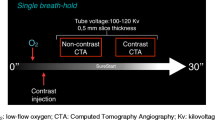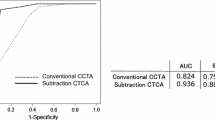Abstract
In conventional coronary computed tomography angiography (CCTA), metal artifacts are frequently observed where stents are located, making it difficult to evaluate in-stent restenosis. This study was conducted to investigate whether subtraction CCTA can improve diagnostic accuracy in the evaluation of in-stent restenosis. Subtraction CCTA was performed using 320-row CT in 398 patients with previously placed stents who were able to hold their breath for 25 s and in whom mid-diastolic prospective one-beat scanning was possible. Among these patients, 126 patients (94 men and 32 women, age 74 ± 8 years) with 370 stents who also underwent invasive coronary angiography (ICA) were selected as the subjects of this study. With ICA findings considered the gold standard, conventional CCTA was compared against subtraction CCTA to determine whether subtraction can improve diagnostic accuracy in the evaluation of in-stent restenosis. When non-assessable stents were considered to be stenotic, the diagnostic accuracy in the evaluation of in-stent restenosis was 62.7 % for conventional CCTA and 89.5 % for subtraction CCTA. When the non-assessable stents were considered to be non-stenotic the diagnostic accuracy was 90.3 % for conventional CCTA and 94.31 % for subtraction CCTA. When subtraction CCTA was used to evaluate only the 138 stents that were judged to be non-assessable by conventional CCTA, 116 of these stents were judged to be assessable, and the findings for 109 of them agreed with those obtained by ICA. Even for stents with an internal diameter of 2.5–3 mm, the lumen can be evaluated in more than 80 % of patients. Subtraction CCTA provides significantly higher diagnostic accuracy than conventional CCTA in the evaluation of in-stent restenosis.





Similar content being viewed by others
References
Miller JM, Rochitte CE, Dewey M, Arbab-Zadeh A, Niinuma H, Gottlieb I, Paul N, Clouse ME, Shapiro EP, Hoe J, Lardo AC, Bush DE, de Roos A, Cox C, Brinker J, Lima JA (2008) Diagnostic performance of coronary angiography by 64-row CT. N Engl J Med 359:2324–2336
Abbara S, Arbab-Zadeh A, Callister TQ et al (2009) SCCT guidelines for performance of coronary computed tomographic angiography: a report of the Society of Cardiovascular Computed Tomography Guidelines Committee. J Cardiovasc Comput Tomogr 3:190–204
Mark DB, Berman DS, Budoff MJ et al (2010) ACCF/ACR/AHA/NASCI/SAIP/SCAI/SCCT 2010 expert consensus document on coronary computed tomographic angiography: a report of the American College of Cardiology Foundation Task Force on Expert Consensus Documents. Circulation 121:2509–2543
Motoyama S, Sarai M, Harigaya H, Anno H, Inoue K, Hara T, Naruse H, Ishii J, Hishida H, Wong ND, Virmani R, Kondo T, Ozaki Y, Narula J (2009) Computed tomographic angiography characteristics of atherosclerotic plaques subsequently resulting in acute coronary syndrome. J Am Coll Cardiol 54:49–57
Inoue K, Motoyama S, Sarai M, Sato T, Harigaya H, Hara T, Sanda Y, Anno H, Kondo T, Wong ND, Narula J, Ozaki Y (2010) Serial coronary CT angiography-verified changes in plaque characteristics as an end point: evaluation of effect of statin intervention. JACC Cardiovasc Imaging 3:691–698
Abdulla J, Pedersen KS, Budoff M, Kofoed KF (2012) Influence of coronary calcification on the diagnostic accuracy of 64-slice computed tomography coronary angiography: a systematic review and meta-analysis. Int J Cardiovasc Imaging 28:943–953
Taylor AJ, Cerqueira M, Hodgson JM et al (2010) ACCF/SCCT/ACR/AHA/ASE/ASNC/NASCI/SCAI/SCMR 2010 appropriate use criteria for cardiac computed tomography. A report of the American College of Cardiology Foundation Appropriate Use Criteria Task Force, the Society of Cardiovascular Computed Tomography, the American College of Radiology, the American Heart Association, the American Society of Echocardiography, the American Society of Nuclear Cardiology, the North American Society for Cardiovascular Imaging, the Society for Cardiovascular Angiography and Interventions, and the Society for Cardiovascular Magnetic Resonance. J Cardiovasc Comput Tomogr 4(407):e1–e33
Yoshioka K, Tanaka R, Muranaka K (2012) Subtraction coronary CT angiography for calcified lesions. Cardiol Clin 30:93–102
Yoshioka K, Tanaka R, Muranaka K, Sasaki T, Ueda T, Chiba T et al (2015) Subtraction coronary CT angiography using second-generation 320-detector row CT. Int J Cardiovasc Imaging 31(Suppl 1):51–58
Amanuma M, Kondo T, Sano T, Sekine T, Takayanagi T, Matsutani H et al (2015) Subtraction coronary computed tomography in patients with severe calcification. Int J Cardiovasc Imaging 31:1635–1642
Fuchs A, Kuhl JT, Chen MY, Helqvist S, Razeto M, Arakita K et al (2015) Feasibility of coronary calcium and stent image subtraction using 320-detector row CT angiography. J Cardiovasc Comput Tomogr. doi:10.1016/j.jcct2015.03.016
Funama Y, Utsunomiya D, Taguchi K, Oda S, Shimonobo T, Yamashita Y (2014) Automatic exposure control at single- and dual-heartbeat CTCA on a 320-MDCT volume scanner: effect of heart rate, exposure phase window setting, and reconstruction algorithm. Phys Med 30:385–390
Williams MC, Weir NW, Mirsadraee S, Millar F, Baird A, Minns F, Uren NG, McKillop G, Bull RK, van Beek EJ, Reid JH, Newby DE (2013) Iterative reconstruction and individualized automatic tube current selection reduce radiation dose while maintaining image quality in 320-multidetector computed tomography coronary angiography. Clin Radiol 68:e570–e577
Razeto M, Matthews J, Masood S, Steel J, Arakita K (2012) Accurate registration of coronary arteries for volumetric CT digital subtraction angiography. In: ICGIP 2012 Proceedings of SPIE Vol. 8768 876834-1
Jinzaki M, Sato K, Tanami Y, Yamada M, Kuribayashi S, Anzai T, Asakura Y, Ogawa S (2006) Novel method of displaying coronary CT angiography: angiographic view. Circ J 70:1661–1662
Austen WG, Edwards JE, Frye RL, Gensini GG, Gott VL, Griffith LS, McGoon DC, Murphy ML, Roe BB (1975) A reporting system on patients evaluated for coronary artery disease. Report of the Ad Hoc Committee for Grading of Coronary Artery Disease, Council on Cardiovascular Surgery, American Heart Association. Circulation 51:5–40
Boll DT, Merkle EM, Paulson EK, Fleiter TR (2008) Coronary stent patency: dual-energy multidetector CT assessment in a pilot study with anthropomorphic phantom. Radiology 247:687–695
Zhou Q, Jiang B, Dong F, Huang P, Liu H, Zhang M (2014) Computed tomography coronary stent imaging with iterative reconstruction: a trade-off study between medium kernel and sharp kernel. J Comput Assist Tomogr 38:604–612
Venema HW, Hulsmans FJ, den Heeten GJ (2001) CT angiography of the circle of Willis and intracranial internal carotid arteries: maximum intensity projection with matched mask bone elimination-feasibility study. Radiology 218:893–898
Uotani K, Watanabe Y, Higashi M et al (2009) Dual-energy CT head bone and plaque removal for quantification of calcified carotid stenosis: utility and comparison with digital subtraction angiography. Eur Radiol 19:2060–2065
Luo Z, Wang D, Sun X, Zhang T, Liu F, Dong D, Chan NK, Shen B (2012) Comparison of the accuracy of subtraction CT angiography performed on 320-detector row volume CT with conventional CT angiography for diagnosis of intracranial aneurysms. Eur J Radiol 81:118–122
Poletti PA, Rosset A, Didier D, Bachmann P, Verdun FR, Rutschmann O, Vallee JP, Terrier F, Khatchatourov G (2004) Subtraction CT angiography of the lower limbs: a new technique for the evaluation of acute arterial occlusion. AJR Am J Roentgenol 183:1445–1448
Yamada M, Jinzaki M, Imai Y, Yamazaki S, Imanishi N, Tanami Y, Yamazaki A, Aiso S, Kuribayashi S (2011) Evaluation of severely calcified coronary artery using fast-switching dual-kVp 64-slice computed tomography. Circ J 75:472–473
Machida H, Tanaka I, Fukui R, Shen Y, Ishikawa T, Tate E, Ueno E (2015) Current and novel imaging techniques in coronary CT. Radiographics 35:991–1010
Einstein AJ, Ellistion CD, Arai AE et al (2010) Radiation dose from single-heartbeat coronary CT angiography performed with a 320-detector row volume scanner. Radiology 254:698–706
Khan A, Nasir K, Khosa F et al (2011) Prospective gating with 320-MDCT angiography: effect of volume scan length on radiation dose. AJR Am J Roentgenol 196:407–411
Fujimoto S, Matsutani H, Kondo T, Sano T, Kumamaru K, Takase S, Rybicki FJ (2013) Image quality and radiation dose stratified by patient heart rate for coronary 64- and 320-MDCT angiography. AJR Am J Roentgenol 200:765–770
Schuetz GM, Schlattmann P, Dewey M (2012) Use of 3 × 2 tables with an intention to diagnose approach to assess clinical performance of diagnostic tests: meta-analytical evaluation of coronary CT angiography studies. BMJ 345:e6717
Onuma Y, Dudek D, Thuesen L, Webster M, Nieman K, Garcia-Garcia HM, Ormiston JA, Serruys PW (2013) Five-year clinical and functional multislice computed tomography angiographic results after coronary implantation of the fully resorbable polymeric everolimus-eluting scaffold in patients with de novo coronary artery disease: the ABSORB cohort A trial. JACC Cardiovasc Interv 6:999–1009
Author information
Authors and Affiliations
Corresponding author
Ethics declarations
Conflict of interest
Dr. M Amanuma, RTs T Sano, T Takayanagi, T Arai, and Dr. S Takase have a contract of research cooperation with The Toshiba Medical Systems Corporation. This investigation was not funded. Drs. K Arakita and A Iwasa are employees of Toshiba Medical Systems Corporation. The other authors declare that they have no conflict of interest.
Ethical approval
All procedures performed in studies involving human participants were in accordance with the ethical standards of the institutional and national research committee and with the 1964 Helsinki declaration and its later amendments or comparable ethical standards.
Informed consent
Written informed consent was obtained from all individual participants included in the study.
Rights and permissions
About this article
Cite this article
Amanuma, M., Kondo, T., Sano, T. et al. Assessment of coronary in-stent restenosis: value of subtraction coronary computed tomography angiography. Int J Cardiovasc Imaging 32, 661–670 (2016). https://doi.org/10.1007/s10554-015-0826-4
Received:
Accepted:
Published:
Issue Date:
DOI: https://doi.org/10.1007/s10554-015-0826-4




